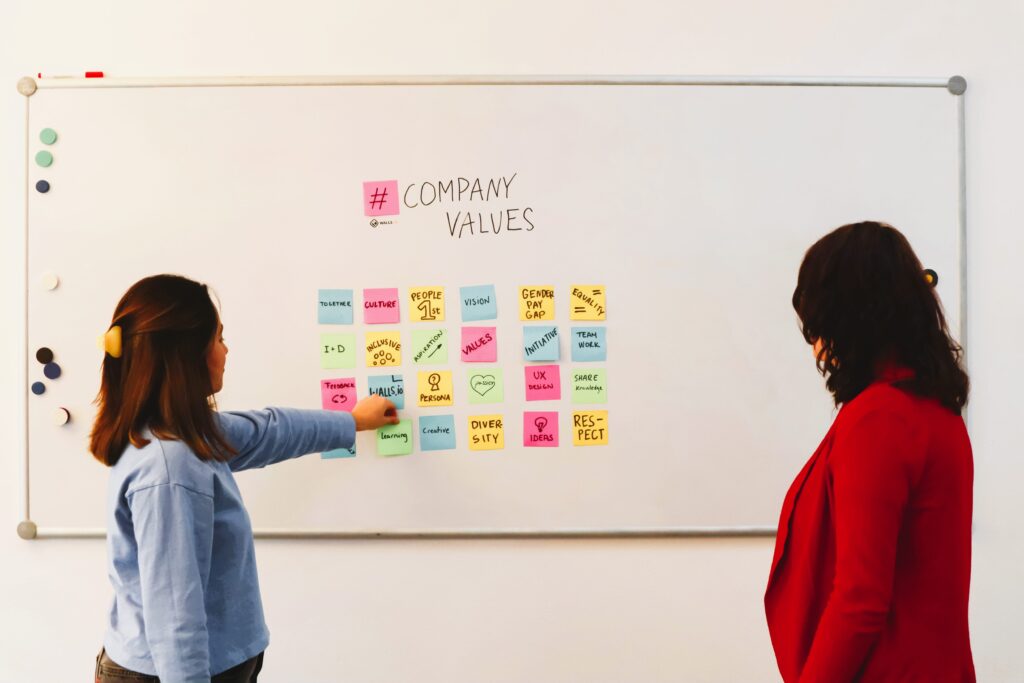Last month, I found myself sitting in a crowded ballroom at a beautiful conference center outside Denver, feeling completely overwhelmed. I was at the WorkHuman Live conference, where every single session — every keynote, every breakout — had something to do with AI. As someone who’s spent over a decade working alongside entrepreneurs and business leaders, I’ve witnessed plenty of technological shifts, but this felt different. Bigger. More transformative. More urgent.
Then Trevor Noah took the stage and completely reframed my thinking. He reminded us that every major innovation follows the same pattern: some things get better, some things get replaced, and entirely new possibilities emerge that we can’t even imagine yet. The automobile didn’t just replace horses; it created entirely new industries, from car manufacturing to ride-sharing apps.
That perspective shift helped me realize that AI transformation isn’t just a technology initiative. It’s the biggest change management opportunity since the advent of the internet, and it’s perfectly positioned for people leaders like us to guide.
The Reality on the Ground
To dig deeper into what this transformation actually looks like, I brought together two remarkable leaders who are navigating it alongside their organizations every day: Hollie Castro, a five-time Chief People Officer with experience across Fortune 500 companies and late-stage startups, and Sangeeta Chakraborty, former CRO at Miro, C-level GTM leader at multiple growth-stage software organizations, and current go-to-market advisor who’s seeing AI reshape sales organizations in real-time.
What they shared was both sobering and encouraging. “There’s a ton of uncertainty and fear in the system right now,” Hollie told me. “People don’t know what’s going to happen, and instead of making decisions, they’re being indecisive.” This uncertainty is affecting everything from expansion plans to hiring decisions.
But here’s what struck me most: despite the uncertainty, the most successful leaders aren’t waiting for perfect clarity. They’re experimenting, learning, and adapting with the kind of bold curiosity that drives breakthrough innovation.
What’s Actually Working
The companies that are thriving with AI transformation share several key characteristics. First and foremost, as Hollie emphasized, they’re “letting the business strategy lead the technology strategy.” The most effective organizations start with fundamental questions: What’s our ambition with AI? What business problem are we solving?
“AI only adds value if it’s supporting the business strategy,” Hollie explained. Too many companies are implementing AI tools simply because they exist, rather than because they solve a specific business need.
“AI only adds value if it’s supporting the business strategy.” – Hollie Castro
Cross-functional collaboration is absolutely essential. The winning companies bring together the Chief People Officer, Chief Technology Officer, and Chief Legal Officer from day one. This triad ensures that ethical, technical, and human considerations are woven together from the start — not added as an afterthought.
Perhaps most importantly, these organizations are building what Hollie calls “agile learning cultures.” Instead of waiting for the perfect plan, they’re running small, visible experiments, conducting regular retrospectives, and creating weekly learning forums. “Transformation happens at the speed of trust,” she noted, “and organizations that actively cultivate trust are the ones winning.”
Innovation in Action
Some of the most compelling examples came from the practical applications leaders are already implementing. Hollie shared how one early-stage company built its entire job family matrix and salary band structure using ChatGPT — a process that typically takes weeks or months was completed in about 10 hours with 90% accuracy.
Another company completely rewrote its employee handbook with a new tone aligned to its strategy. Others are creating bite-sized learning paths, summarizing complex proxy statements from 20 competitors, and even building comprehensive internship programs from scratch.
Beyond HR-specific applications, leaders are discovering AI’s versatility across business functions. Hollie described using AI to analyze complex investment decisions, feeding it financial, emotional, and practical considerations to generate concrete recommendations. “It helped me build a case for the hypothesis I had, and it was convincing enough that we went with that recommendation,” she explained.
Another breakthrough came when she needed to analyze hundreds of pages of competitive intelligence — proxy data and annual reports from multiple companies. AI processed this massive dataset to create clear comparison tables highlighting key similarities and differences, a task that would have taken weeks to complete manually.
On the sales side, Sangeeta described a fascinating shift in leadership, with top CROs diving into tools like Claude and ChatGPT to grasp the possibilities and guide their teams in building custom AI agents that align with the business goals. This hands-on approach represents a fundamental change. Sales leaders who traditionally relied on vendors for their tech stack are now immersing themselves in three-hour YouTube tutorials to understand how to build AI agents themselves.
But perhaps the most intriguing example came from Tracy Franklin, CHRO at Moderna, who leveraged personality tests to create simulated GPT versions of her executive team to predict and model potential conflicts.
At the Fortune WorkPlace Summit, Tracey shared, “I think I’m pretty good with people, but it gives me an advantage that I didn’t have before because I don’t fully understand someone’s innate human personality response, like the GPT allows me to do.”
Embracing the Hard Truths About Job Transformation
Let’s address the elephant in the room: yes, some jobs are evolving dramatically, and others are going away entirely. Sangeeta was refreshingly direct about this reality. Take the traditional entry-level sales development representative role, for example: it’s centered on prospects and doing basic research and is one of the first to be reviewed to see what can be automated. This is reflected in the growth of the AI SDR. While the tech is not perfect yet, it’s clear AI is encroaching on similar roles in other fields — a point echoed by Dario Amodei, CEO of Anthropic, in his recent interview on CNN.
“Before anybody asks me to spend money, I’m asking, ‘Can an AI tool do this?’ Before anyone asks me to hire anyone, I’m asking, ‘Can AI do this?'” she explained.
But here’s her empowering advice: “You have to figure out how you can disrupt your own job function before somebody else demands it of you.” The key is moving up the value creation ladder, developing more complex skills, and continuously reinventing your contribution.
“You have to figure out how you can disrupt your own job function before somebody else demands it of you.” – Sangeeta Chakraborty
This applies to all of us, not just entry-level employees. As Sangeeta put it, “We are all going to be in that situation if we’re not already. We are being evaluated every single day with even more stringent expectations.”
The opportunity lies in partnering with AI to amplify our uniquely human capabilities rather than competing against it.
Organizations are responding by fundamentally rethinking workforce development. Gartner research indicates that while only a third of HR leaders plan to add GenAI-related roles in the next 12 months, those who are investing in upskilling existing employees and identifying AI talent are positioning themselves for sustainable competitive advantage.
Navigating the Challenges
Of course, AI transformation comes with significant challenges, particularly around data protection and bias. Hollie’s guidance is both practical and actionable: use enterprise-grade tools, create secure sandboxes for proprietary data, and invest meaningfully in training and awareness.
“If you think your employees aren’t using AI, you’re wrong,” she warned. “They’re just using it at home, in an even more insecure environment.” The solution isn’t prohibition. It’s thoughtful enablement with proper guardrails.
“If you think your employees aren’t using AI, you’re wrong. They’re just using it at home, in an even more insecure environment,” Sangeeta warned.
The bias issue is equally critical, especially in recruitment and performance management. Recent SHRM research reveals that while nearly half of HR professionals say AI has become a priority in the last 12 months, one of the top barriers to adoption is “a lack of resources to properly audit AI algorithms.” This gap is concerning, given that 64% of organizations using AI are applying it to talent acquisition — where bias can have the most significant impact.
The key is asking the right questions upfront: What biases might already be embedded in our data? Are we auditing algorithms before deployment? Do employees have a way to challenge AI-driven decisions? Are we examining outcomes across different demographic groups over time?
Your Journey Forward
Coming out of this conversation, I’ve distilled my own action plan into manageable steps. My immediate focus is creating a framework to assess what AI capabilities already exist across our firm, identifying opportunities, and laying groundwork for future workflow and organizational assessments.
Here’s what I recommend for people leaders ready to embark on this transformation:
Build your coalition early. Bring together your technology and legal teams from the beginning. This isn’t a solo journey. As Hollie emphasized, cross-functional collaboration from day one ensures that ethical, technical, and human considerations are woven together rather than addressed as afterthoughts.
Experiment boldly. Follow Hollie’s lead and try 10 experiments a week. Document what works, what doesn’t, and why. This experimental mindset is paying off — Gartner found that HR leaders conducting AI pilots and planning implementations doubled from June 2023 to January 2024.
Invest in trust and transparency. Be explicit about when and how AI is being used in your organization. Create channels for feedback and concerns. Transformation happens at the speed of trust, and people need to understand not just what you’re doing, but why and how it affects them.
Learn continuously. As Sangeeta emphasized, this isn’t optional anymore — it’s essential. Block time on your calendar for AI learning and experimentation.
The transformation is happening whether we’re ready or not. But as I learned from Trevor Noah’s perspective and my conversation with Hollie and Sangeeta, we have more agency in shaping this change than it might feel like in those overwhelming “everyone is doing it” conference moments.
The question isn’t whether AI will reshape work — it’s whether we’ll guide that transformation alongside our teams or simply react to it. For people leaders, this represents perhaps the greatest opportunity in our careers to lead the people and business strategies that will create meaningful organizational change. The time to start is now.




